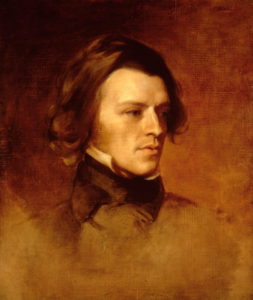by Ann Kennedy Smith
Alfred Lord Tennyson (1809-1892) is often seen as a very British poet. A new book, The Reception of Alfred Tennyson in Europe, examines how Tennyson’s poetry was published, distributed, translated and reviewed in the wider context of Europe from 1832 until today. I wrote about his French reception in it, and in this blog I’ll focus on some of the French poets and writers who admired, were influenced by, borrowed or stole from Tennyson.
Perhaps surprisingly, one of Tennyson’s very first fan letters was from a French poet. Hippolyte Lucas’s first collection of poetry was published in 1832, the same year that Tennyson’s early Poems appeared. Lucas’s letter has since been lost, but Tennyson’s reply of April 1834 shows how flattered he was to receive it.
It is a pleasurable thing to have found out a poetical spirit that can sympathize with me on the other side of the broad seas. Poets, as you say, are – at least they ought to be – bound together by an electric chain – for a Poet does not speak only to his own countrymen but wishes that his words and feelings penetrate wherever there exists a brother to echo them.[i]
Was the ‘electric chain’ that Tennyson refers to here connected to early experiments in electrical telegraphy? It’s a delightful image if so, evoking an international network of poets communicating and sharing their ideas across borders, regardless of differences in language and culture. Unfortunately, his optimism was unfulfilled, and for many years Tennyson’s poetry went largely unread outside Britain. Most nineteenth-century Europeans were still in love with the dashing, dramatic poetry of Lord Byron, who had died a hero fighting for Greek independence, and Tennyson seemed rather tame and insular by comparison.
But French poets did continue to read Tennyson, sometimes discovering his poetry through unusual channels. In 1851 Charles Baudelaire was preparing to translate some stories by Edgar Allan Poe, then a little-known writer. By chance he came across an obituary of Poe by the editor John R. Thompson. ‘Among modern authors his favourite was Tennyson,’ Thompson wrote,
and he delighted to recite from ‘The Princess’ the song ‘Tears, idle tears’; a fragment of which ‘– when unto dying eyes / The casement slowly grows a glimmering square’ he pronounced unsurpassed by any image expressed in writing.[ii]
This was Baudelaire’s introduction to the English poet’s work and he began reading it in earnest. Six years later he instructed his publisher to send copies of his own first collection of poetry, Les Fleurs du mal (1857) to just three English writers: De Quincey, Browning and Tennyson. We don’t know if Tennyson ever received it. Soon afterwards Baudelaire was prosecuted for offending public morals, and all remaining books were seized and destroyed.
Other French poets paid tribute to Tennyson by borrowing freely from him. Joseph Autran’s ‘Gertrude’ (1856) was a straightforward translation of Tennyson’s ‘Dora’, even if Autran did not admit it. André Theuriet’s eleven-part poem ‘In Memoriam’ (1857) went further, taking the name and theme of deep mourning from Tennyson’s 1850 work, and inserting lines from ‘Mariana’, an earlier poem.
In 1864 Tennyson’s Enoch Arden, etc was an immediate bestseller both in Britain and in Europe. The title poem tells the story of a shipwrecked sailor who returns home after ten years to find his wife, believing him dead, has remarried. It struck a lasting chord with French readers, and was translated many times over the years. One translator, Émile Blémont, agreed with Browning who admired Tennyson’s poem but disliked the ending. So Blémont simply changed it. In his translation, the heroic Enoch ensures that his identity is kept secret after his death. The poet Stéphane Mallarmé loved Blémont’s version: ‘The real translation! And how one hears Tennyson singing through it, if one has the slightest ear for English!’[iii] Mallarmé himself had published a ‘poetic prose’ translation of ‘Mariana’ in 1874 while translating Poe’s stories. As Gerhard Joseph has pointed out, the musicality of Poe’s and Tennyson’s English language inspired the French poet’s own stylistic concept of pure poetry.[iv] Mallarmé acknowledged his debt to the English poet in his 1892 essay ‘Tennyson, vu d’ici’ (‘Tennyson, seen from here’) which was included in his collection of poetic critical essays, Divagations in 1897.[v]
Other French writers took a less reverent approach. Émile Zola’s brilliant novella, Jacques Damour (1880), about a former Communard who returns to Paris after the amnesty to find his newly bourgeois wife does not want him back, is clearly a satirical reworking of ‘Enoch Arden’. Zola always claimed that he had never read a line of Tennyson, but I’m convinced that he knew the story well. One mystery remains. Did Victor Hugo ever read Tennyson? If he did, he kept quiet about it. Despite their political differences, Tennyson read and admired Hugo’s poetry throughout his life, and even wrote a questionable sonnet in his honour. Unfortunately – or perhaps fortunately – Hugo did not return the compliment.
Bio:
Dr Ann Kennedy Smith is a panel tutor at Cambridge University’s Institute of Continuing Education. She is currently researching Cambridge’s university wives 1870-1914, and has contributed to the Oxford Dictionary of National Biography. Her Twitter handle is @akennedysmith.
Notes
[i] The Letters of Alfred Lord Tennyson eds Cecil Y. Lang and Edgar F. Shannon, 3 vols (Oxford: Clarendon Press, 1982–90). III: 451
[ii] ‘The Late Edgar E. Poe’ (1849), in appendix of Edgar Allan Poe: sa vie et ses ouvrages, Charles Baudelaire, W.T. Bandy (ed.), (Toronto and Buffalo: University of Toronto Press, 1973)
[iii] Clerget, F., Emile Blémont (Paris: Bibliothèque de l’Association, 1906) pp. 130–31
[iv] ‘Stéphane Mallarmé’s Tennyson vu d’ici’ in Tennyson Research Bulletin, 7. 5: November 2001
[v] In Mallarmé in Prose, Caws, M. A. (ed.) (New York: New Directions Publishing Corporation, 2001) pp. 70–73

